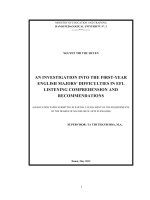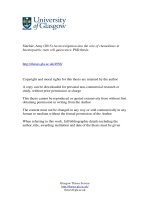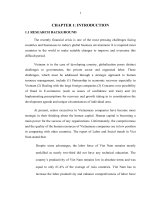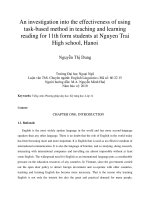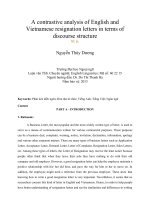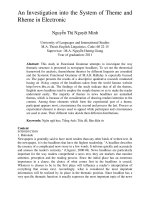An investigation of the effects of SFAS no 121 on asset impairment reporting and stock returns
Bạn đang xem bản rút gọn của tài liệu. Xem và tải ngay bản đầy đủ của tài liệu tại đây (622.11 KB, 119 trang )
AN INVESTIGATION OF THE EFFECTS OF SFAS NO.121 ON ASSET
IMPAIRMENT REPORTING AND STOCK RETURNS
Waleed Mohammad Alshabani, B.S., M.S. Accounting
Dissertation Prepared for the Degree of
DOCTOR OF PHILOSOPHY
UNIVERSITY OF NORTH TEXAS
December 2001
APPROVED:
K. K. Raman, Major Professor
Margie Tieslau, Minor Professor
Ted Coe, Committee Member
Paul Hutchison, Committee Member
Barbara Merino, Coordinator of the
Program in Accounting
John Price, Chair of the Department of
Accounting
Jared E. Hazleton, Dean of the College
of Business Administration
C. Neal Tate, Dean of the Robert B.
Toulouse School of Graduate
Studies
UMI Number: 3073698
Copyright 2001 by
Alshabani, Waleed Mohammad
All rights reserved.
________________________________________________________
UMI Microform 3073698
Copyright 2003 ProQuest Information and Learning Company.
All rights reserved. This microform edition is protected against
unauthorized copying under Title 17, United States Code.
____________________________________________________________
ProQuest Information and Learning Company
300 North Zeeb Road
PO Box 1346
Ann Arbor, MI 48106-1346
Alshabani, Waleed Mohammad, An investigation of the effects of SFAS No.121
on asset impairment reporting and stock returns. Doctor of Philosophy (Accounting),
December 2001, 109 pp., 6 tables, 9 exhibits, 1 figure, references, 48 titles.
Prior to Statement of Financial Accounting Standards No.121 (SFAS No.121):
Accounting for the Impairment of Long-Lived Assets and Long-Lived Assets to Be
Disposed Of, managers had substantial discretion concerning the amount and timing of
reporting writedowns of long-lived assets. Moreover, the frequency and dollar amount of
asset writedown announcements that led to a large “surprise” caused the Financial
Accounting Standards Board (FASB) and the Securities and Exchange Commission
(SEC) to consider the need for a new standard to guide the recording of impairment of
long-lived assets.
This study has two primary objectives. First, it investigates the effects of SFAS
No.121 on asset impairment reporting, examining whether SFAS No.121 reduces the
magnitude and restricts the timing of reporting asset writedowns. Second, the study
compares the information content (surprise element) of the asset impairment loss
announcement as measured by cumulative abnormal returns (CAR) before and after the
issuance of SFAS No.121.
The findings provide support for the hypothesis that the FASB’s new accounting
standard does not affect the magnitude of asset writedown losses. The findings also
provide support for the hypothesis that SFAS No. 121 does not affect the management
choice of the timing for reporting asset writedowns. In addition, the findings suggest that
the market evaluates the asset writedown losses after the issuance of SFAS No. 121 as
good news for “big bath” firms, while, for “income smoothing” firms, the market does
i
not respond to the announcements of asset writedown losses either before or after the
issuance of SFAS No. 121. The findings also suggest that, for “big bath” firms, the
market perceives the announcement of asset impairment losses after the adoption of
SFAS No. 121 as more credible relative to that before its issuance. This could be because
the practice of reporting asset writedowns after the issuance of SFAS No. 121 is under
the FASB’s authoritative guidance, which brings consistency and comparability in asset
impairment reporting.
ii
Copyright 2001
by
Waleed Mohammad Alshabani
ii
TABLE OF CONTENTS
Page
LIST OF TABLES....................................................................................................... v
LIST OF EXHIBITS.................................................................................................... vi
LIST OF ILLUSTRATIONS ....................................................................................... vii
Chapter
1. INTRODUCTION......................................................................................
1
1.1 Introduction
1.2 The Importance of the Asset Writedown Event
1.3 Research Questions
2. BACKGROUND ON SFAS NO.121 .......................................................... 11
2.1 Introduction
2.2 The Background of SFAS No.121 Issuance
2.3 Scope
2.4 Asset Impairment Investigations
2.5 Evaluation for Asset Impairment
2.6 Impairment Loss Measurement
2.7 Impairment Loss Recognition
2.8 Goodwill
2.9 Asset Groupings
2.10 Reporting and Disclosing Asset Impairments
2.11 Assets to be Disposed of
2.12 Effective Date and Transition
2.13 Future of SFAS No. 121
3. LITERATURE REVIEW ........................................................................... 27
3.1 Asset Writedowns Literature Review
3.1.1 Introduction
3.1.2 Asset Writedowns: Impairment or Manipulation
3.1.3 Market-Adjusted Security Returns Behavior
3.1.4 Repeated Accounting Asset Writedowns
3.1.5 Asset Writedowns and Concurrent Abnormal Accruals
iii
3.1.6 Summary
3.2 Earnings Management and Asset Writedowns
3.2.1 Introduction
3.2.2 Objectives of Earnings Management
3.2.3 Techniques of Earnings Management
3.2.4 Earnings Management Tools
3.2.5 Diminutions of Earnings Management
3.2.6 Asset Writedowns and Earnings Management
3.2.7 Summary
4. RESEARCH HYPOTHESES AND METHODOLOGY ............................. 46
4.1 Research Hypotheses
4.2 Research Methodology
4.2.1 The Random-Effects Tobit Model
4.2.2 The Asset Writedown Magnitude Hypothesis (H1)
4.2.3 The Binary Dependent Variable Panel Data Model
4.2.4 The Asset Writedown Timing Hypothesis (H2)
4.2.5 The Traditional Random-Effects Panel Data Model
4.2.6 The Asset Writedown Informational Content Hypothesis (H3)
4.3 Cumulative Abnormal Returns (CAR)
4.4 Sample Selection
5. RESEARCH FINDINGS ............................................................................ 65
5.1 Introduction
5.2 Descriptive Statistics and Sample Characteristics
5.3 Results of Testing the Three Different Hypotheses
5.3.1 Results of Testing Hypothesis 1 (Asset Writedown Magnitude)
5.3.2 Results of Testing Hypothesis 2 (Timing of Reporting Asset
Writedown Loss)
5.3.3 Additional Analysis
5.3.4 Results of Testing Hypothesis 3 (Information Content)
6. RESEARCH SUMMARY AND CONCLUSIONS ..................................... 83
APPENDIX ................................................................................................................. 89
REFERENCES ............................................................................................................106
iv
LIST OF TABLES
Table
Page
1. Compustat Firms With Negative Special Items in Excess of 1% Assets During
1982-1992..............................................................................................................90
2. Distribution of Writedowns During 1980-1985. ......................................................91
3. Sample Characteristics............................................................................................92
4. The Study’s Sample by Year, Earning Management Technique. ..............................93
5. The Study’s Sample by Earning Management Technique, and SFAS No. 121
Adoption ................................................................................................................94
6. Writedown Firms by Earning Management Technique and SFAS No. 121
Adoption ................................................................................................................95
v
LIST OF EXHIBITS
Exhibit
Page
1. The Results of the Random-Effects Tobit Model Used to Test Hypothesis 1........... 96
2. The Results of the Binary Dependent Panel Data Model Used to Test
Hypothesis 2........................................................................................................... 97
3. The Results of the New Tobit Model Used in Testing the Magnitude
Hypothesis for Both “Big Bath” and “Income Smoothing” Firms ........................... 98
4. The Results of the Traditional Random-Effects Panel Data Model Used in the
Initial Testing of Hypothesis 3 - Event Window (-1, 1) ........................................... 99
5. The Results of the Traditional Random-Effects Panel Data Model Used in the
Initial Testing of Hypothesis 3 - Event Window (-2, 2) ...........................................100
6. The Results of the Traditional Random-Effects Panel Data Model Used in the
Initial Testing of Hypothesis 3 - Event Window (-3, 3) ...........................................101
7. The Traditional Random-Effects Panel Data Model Used to Test Hypothesis
3 - Event Window (-1, 1)........................................................................................102
8. The Traditional Random-Effects Panel Data Model Used to Test Hypothesis
3 - Event Window (-2, 2)........................................................................................103
9. The Traditional Random-Effects Panel Data Model Used to Test Hypothesis
3 - Event Window (-3, 3)........................................................................................104
vi
LIST OF ILLUSTRATIONS
Figure
Page
1. Figure 1: FASB Statement No. 121 ........................................................................105
vii
CHAPTER ONE
INTRODUCTION
1.1 Introduction
The primary role of accounting standard setters is to define the accounting
language that is used by management to communicate with the firm’s external
stakeholders. Stakeholders include current or potential investors and creditors; employees
and their unions; financial intermediaries such as auditors, financial analysts, and bond
rating agencies; regulators; suppliers; and customers. Corporate managers, through the
use of accounting standards established by the Financial Accounting Standards Board
(FASB), convey private information on their firm’s performance to external capital
providers and other stakeholders. Therefore, financial reporting is intended to allow the
best-performing firms in the economy to distinguish themselves from the poorperforming firms, thus facilitating efficient resource allocation and stewardship decisions
by stockholders (Healy and Wahlen 1998). New financial accounting standards,
therefore, add value if they enable financial statements to effectively communicate
differences in firms’ economic positions and performance in a timely and credible
manner.
Since financial accounting reports convey managers’ private information on their
firm’s performance, standards have to permit managers to exercise judgment in financial
reporting and to have discretion over reporting financial information. Managers can then
use their knowledge about the business and its opportunities to select reporting methods
1
and estimates that match the firm’s economics. However, because auditing is imperfect
and management has its own incentives, management’s use of judgment also creates
opportunities for “earnings management” in which managers choose reporting methods
and estimates that do not adequately reflect their firm’s underlying economics. Therefore,
management’s use of judgment in financial reporting has both costs and benefits. The
costs are the potential misallocation of resources that arise from earnings management.
Benefits include potential improvements in management’s credible communication of
private information to external stakeholders. Thus, it is critical for standard setters, for
example, the FASB, to evaluate standards in order to establish the reasonable degree of
discretion that allows for higher accounting information value.
In March 1995, the FASB issued Statement of Financial Accounting Standards
No. 121 (SFAS No.121): Accounting for the Impairment of Long-Lived Assets and LongLived Assets to Be Disposed Of. This statement mandates that, under certain
circumstances, property, plant and equipment; identifiable intangible assets; and goodwill
arising from purchasing these assets should be deemed “impaired” and written down to a
new carrying amount. This standard was issued in response to the diverse practices in
recognizing asset writedowns and in response to the increased frequency and large
amounts of asset writedowns. Prior to the issuance of SFAS No.121, no explicit guidance
existed on accounting for the impairment of long-lived assets, whereas the authoritative
accounting literature was specific regarding the appropriate treatment of declines in the
value of short-term assets (e.g., inventory and marketable securities). Although the
Accounting Principles Board (APB) Opinion No. 17: Intangible Assets (1970) indicates
that one general problem associated with accounting for long-lived assets is determining
2
when carrying amounts have declined “permanently and substantially,” a framework for
determining when a writedown loss should be recorded and how should it be measured is
not provided. This absence of explicit guidance for asset impairments permitted
substantial management discretion over amounts, presentation, and timing of writedowns.
Many of these writedown decisions had substantial economic consequences, for example,
lowering reported earnings. Specifically, management had the ability to affect when the
writedown was reported and to affect the amount of the writedown, given the subjectivity
of the many estimates that were required. In addition to their timing and magnitude,
management also varied the presentation of discretionary write-offs. For instance, during
the 1960s, the fundamental question was whether material, but irregular or infrequent,
charges were to be disclosed as prior-period adjustments in the statement of retained
earnings or as a part of the earnings statement. In 1966, APB Opinion No. 9: Reporting
the Results of Operations (APB9) adopted the all-inclusive income concept, although a
few items continued to qualify as prior-period adjustments. While it is required by APB 9
to report most losses in the earnings statement, management sought to treat asset
writedown losses as non-operating and nonrecurring (Elliott and Shaw 1988). Therefore,
SFAS No.121 was issued to reduce management’s discretion over reporting asset
impairment in order to reduce the potential of earnings management.
Francis et al. (1996) believe that the expressed demands for authoritative guidance
on accounting for asset impairments appear to be based on a notion that management
takes advantage of the discretion afforded by the accounting rules to manipulate earnings.
Earnings could be manipulated either by not recognizing impairment when it has
occurred or by recognizing it only when it is advantageous to do so. Moreover, since
3
managers have incentives to manage earnings and investors are unable to undo these
manipulations, an authoritative guidance on asset impairment was needed. In addition,
the FASB’s decision that accounting for long-lived assets and identifiable intangibles to
be disposed of should be included in the scope of SFAS No.121 could be seen as
evidence of the implicit motivation of adopting SFAS No.121. In the FASB’s view, “if
those assets were not addressed, an entity could potentially avoid the recognition of an
impairment loss for assets otherwise subject to an impairment write-down by declaring
that those assets are held for sale” (FASB, 1995, par 47). Therefore, SFAS No.121 was
issued in order to restrict management’s opportunities of managing earnings through
asset writedown decisions.
Many members of the Financial Accounting Standards Advisory Council
(FASAC) asserted that the problem of large “surprise” asset writedowns was significant
enough to make asset impairment one of the most important issues for the FASB to
address (FASB, 1995, par. 41). Large “surprise” asset writedowns might be seen either as
possible management manipulation or real asset impairment. Zucca and Campbell (1992)
reported that 87% of the firms disclosed asset writedowns either as a fourth-quarter
adjustment in their annual report or as an asset writedown loss in their annual report
without indicating to which quarter it pertained. This finding substantiates the claim of
many analysts that the discretionary writedown of long-lived assets has a “surprise”
element. Managers prefer to wait until earnings and stock performance for the fiscal year
are known, so that they may then use this information in deciding whether to take a
writedown or not (Alciatore et al. 1998). This action by firms encouraged the FASB to
issue SFAS No.121 in order to minimize any possible management manipulation in
4
accounting earnings. That is, the FASB attempted to place some constraints on
management’s practice of asset writedown reporting.
However, the issuance of SFAS No.121 was not expected to eliminate or reduce
management discretion over the timing and amount of asset writedowns. Rees et al.
(1996) and Munter (1995), among others, argue that although SFAS No.121 provides
specific examples of changes in circumstances that indicate a need for review of asset
values, management’s estimates of future cash flows determine whether a writedown is
necessary. Furthermore, due to the absence of quoted prices for many firm-specific
assets, it is likely that management estimates of fair value will determine the amount of
the asset writedown. Zucca (1997) believes that there are some areas of SFAS 121 in
which its application is subject to the judgment and assumptions of management: 1) the
definition of impairment indicators, 2) the estimation of future cash flows from the use of
the asset, 3) the asset grouping level at which testing and measurement occur, and 4) the
depreciation methods chosen for the asset. Booker (1996) believes that much judgment
will be needed to implement the standard. Identification of those assets that might be
impaired, estimating future cash flows, fair values and making grouping decisions will all
require judgment. Titard and Pariser (1996) state that FASB’s approach in SFAS No.121
gives management substantial flexibility to exercise judgment in determining and
reporting impairment losses. Some of its provisions are broad enough to enable
management to formulate aggressive or conservative approaches to the recognition of
asset impairment losses. Therefore, reducing management discretion over the timing and
amount of asset writedowns by the issuance of SFAS No.121 is somewhat questionable.
5
This study investigates the effect of SFAS No.121 on asset impairment reporting,
attempting to discover whether SFAS No.121 has decreased management’s discretion
over asset writedown decisions. Moreover, it examines the information content of asset
impairment loss announcements after the issuance of SFAS No.121, as measured by the
cumulative abnormal returns (CAR). The following section discusses the importance of
the asset writedown announcement and its potential effect on the stock price.
1.2 The Importance of the Asset Writedown Event
The increasing prevalence of writedowns in the 1990s is documented in numerous
articles in the popular press (e.g., Brown 1991), in the attention given to writedown by
regulatory bodies (e.g., Spindel 1991), and in the academic empirical research on asset
writedowns (e.g., Elliot and Shaw 1988; Elliot and Hanna 1996; and Francis et al. 1996).
One example is Bausch & Lomb, which reported a surprise writedown loss that was
headlined in USA Today dated January 26, 1995. Bausch & Lomb’s stock price plunged 2
¼ points on the day of that announcement. The Wall Street Journal began its report of
Bausch & Lomb’s 1994 earnings with the following explanation: “Bausch & Lomb, Inc.,
struggling to straighten out several core businesses, took several one-time costs that
resulted in substantial loss in the period” (Bounds 1995, p. A4). Among Bausch &
Lomb’s problems were a decrease in its expected return on sales from its oral-care
business, which it considered an asset impairment (Scofield 1995).
Elliott and Shaw (1988) and Francis et al. (1996) identified Compustat firms with
calendar year-ends with negative special items constituting at least 1% of end-of-year
total assets (see Table 1). A special item is defined in the Compustat database as a charge
that is either unusual or infrequent, but not both, and is therefore separately disclosed in
6
the earnings statement on a pretax basis. As Table 1 clearly indicates, the frequency of
writeoffs has increased sharply since 1982. The Compustat firms that reported negative
special items increased from 59 firms in 1982 to almost double that in 1985 and then
sharply increased within five years to 535 firms.
Moreover, Fried et al. (1989) conducted a study to provide insights into the
development of additional standards for accounting and reporting impairments and
writeoffs of long-lived assets. Part of their sample consisted of 324 companies with 623
writeoffs in the years 1980-1985, which reflected an average of almost two (1.92 =
623/324) writeoffs per firm over six years or one writeoff every three years. The
distribution of writeoffs in terms of frequency and dollar amount for that sample is
presented in Table 2. As this table clearly indicates, the frequency and total dollar amount
of writeoffs increased sharply over time. Fried et al. (1989) emphasized that the increase
in dollar amount is not solely the result of increased frequency but also of the average
dollar amount of writeoffs, which grew sharply over the 1980-1985 period. The average
post-tax amount was $21 million in 1980, increasing steadily to $44 million in 1984, and
then almost doubling in 1985 to $100 million. On a pre-tax basis the results are similar.
Moreover, based on Elliott and Shaw (1988), the average percentage of asset writedowns
to total assets was 8.2% for the 1982-1985 period. Similarly, Francis et al. (1996)
reported that the average percentage of asset writedowns to total assets was 6.7% for the
1988-1992 period. This clearly shows the importance of the asset writedown event and its
effect on a firm’s earnings and returns. The frequency and dollar value of asset
writedowns made the FASB and the Securities and Exchange Commission (SEC)
7
consider a new standard to guide the recording of impairment of long-lived assets. The
following section develops and discusses this study’s research questions.
1.3 Research Questions
Many researchers (e.g., Francis et al. 1996; Rees et al 1996) believed that SFAS
No.121 was issued as a response to management’s discretion over asset writedowns,
which led to large “surprises” that were reflected in the cumulative abnormal returns
(CAR). Therefore, this study investigates whether SFAS No.121 decreased
management’s discretion over asset writedown decisions. Moreover, the study examines
the information content of the asset impairment loss announcements after the issuance of
SFAS No. 121. The research questions are as follows:
What are the effects of SFAS No.121 on management’s discretion over asset
writedown reporting? Are the effects of SFAS No.121 reflected in the stock
market?
To answer these research questions, the study has investigated the sources of
discretion that management has when reporting asset writedowns. Management has
substantial discretion over the amount, presentation, and timing of reporting writedowns
of long-lived assets, which are three ways that are used when managing earnings. After
the issuance of SFAS No.121, the discretion over asset writedown presentation was
restricted by the statement’s requirement of reporting the writedown losses as a
component of income from continuing operations before income taxes. Management
discretion about the amount and timing of reporting asset writedowns still exists. In order
to examine whether SFAS No.121 reduces management discretion over asset writedowns
decisions, this study examines the two other sources of management’s discretion related
to asset writedowns, that is, the amount and timing of reporting asset writedowns.
8
Moreover, the study investigates the effect of SFAS No.121 on the market surprise as
reflected in the CAR. It is hypothesized that the information content of the asset
writedown announcements before and after the issuance of SFAS No.121 will be
different from each other.
Therefore, the research questions are as follows:
1. Does SFAS No.121 restrict management’s opportunities to record long-lived asset
writedowns? That is, does SFAS No. 121 reduce the magnitude and restrict the
timing of reporting asset writedowns?
2. Do asset writedown losses that are reported after the issuance of SFAS No.121
have lower/higher information content as measured by CAR? That is, during the
period surrounding the release of asset writedown announcement, does the CAR
of companies adopting SFAS No.121 differ from the CAR of companies that
announced asset impairment before the adoption of SFAS No.1211?
The issue of whether SFAS No.121 constrains management’s discretion in
recognizing asset impairment losses does not appear to have been investigated in the
prior literature. Since the asset writedown literature is based primarily on observing and
analyzing asset writedown practices in the absence of authoritative guidance, the findings
from that literature cannot be fully utilized without investigating the effect of SFAS
No.121 on the management’s discretion over measuring and reporting asset impairment.
This study also provides evidence as to whether previous asset writedown literature can
be extended in the same direction, that is, asset writedowns as discretionary events. In
addition, this study provides standard setters, i.e., the FASB, an answer to the central
question as to whether too much judgment is allowed to management under SFAS
No.121 in reporting asset writedowns.
9
In summary, the objective of this study is to investigate whether SFAS No.121
restricts management’s discretion over reporting asset impairment and whether SFAS
No.121 helped in reducing earnings management through reporting asset impairment
losses. The next chapter presents an overview of the background of SFAS No.121 and
reviews the various provisions of that standard.
1
The same methodology was used by Mittelstaedt et al. (1992) in their study about the informativenses of
“consistency modifications” to equity markets.
10
CHAPTER TWO
BACKGROUND ON SFAS NO.121
This study reviews and discusses SFAS No.121 and its major requirements, with a
critique of some of those requirements in this chapter.
2.1 Introduction
Under generally accepted accounting principles (GAAP), long-lived assets are
initially recorded at historical cost, which approximates fair value at acquisition. With the
exception of the cost of most land acquisitions, cost is allocated through depreciation and
amortization processes. Cost less depreciation or amortization is reported in the balance
sheet and is referred to as the “carrying amount.” Since accounting depreciation and
amortization is aimed at cost allocation not valuation, carrying amounts of long-lived
assets may be less than or greater than their fair values. Before SFAS No.121, accounting
standards generally did not address when impairment losses should be recognized or how
impairment losses should be measured (FASB, 1995, par 2).
In 1995, the FASB issued SFAS No.121, which provides guidance to preparers of
financial statements on how to identify impaired assets, how to estimate the fair value of
impaired assets, and how to disclose asset impairment to financial statement users. This
standard helps users by bringing some consistency to a previously unstructured area of
accounting (Scofield 1995). A summary of the underlying background of the SFAS
No.121 adoption and the major requirements of it are presented next.
11
2.2 The Background of SFAS No.121 Issuance
Before SFAS No.121, companies generally wrote down an asset when there was
evidence of permanent impairment in the ability to fully recover the asset’s carrying
amount. Companies did this without following any specific authoritative guidance (Titard
and Pariser 1996). As a result, practice was diverse. Managers had the opportunity to
estimate how much and when to record long-lived asset writedowns. This gave
management some ability to manage their firm’s earnings in their own or their firm’s best
interest. This fact led the regulatory bodies to discuss the impairment issue during the
1980s and up to the mid-1990s.
In July 1980, the Accounting Standards Executive Committee of the American
Institute of Certified Public Accountants (AcSEC) sent the FASB an Issues Paper.
AcSEC advised the FASB to provide specific authoritative accounting guidance for the
impairment of assets. However, in the same year, the Financial Accounting Standards
Advisory Council (FASAC) also discussed accounting for impairment of long-lived
assets and recommended that the FASB continue its work on the conceptual framework
project and other agenda topics before adding a project on impairment of assets (FASB,
1995, par 38 & 39). After five years, in March 1985, FASAC members believed that
impairment of assets was the second most important issue for the FASB to address.
Moreover, in September 1986, most FASAC members supported adding a project on
impairment to the FASB technical agenda.
Other accounting authoritative bodies also saw the need to examine the issue of
impairment. The FASB Emerging Issues Task Force (EITF) discussed the issue of
impairment at its meetings in October 1984, December 1985, and February 1986. EITF
12
members noted that there were divergent measurement practices in asset impairment
accounting. Its members also noted a significant increase in the frequency and size of
writedowns of long-lived assets (FASB, 1995, par 40). In September 1986, the
Committee on Corporate Reporting of the Financial Executives Institute (FEI) published
the results of its Survey on Unusual Charges. They indicated various reporting and
measurement practices (FASB, 1995, par 42). In May 1987, the Institute of Management
Accountants (IMA) adopted a research study to examine accounting for asset impairment.
The IMA research report, Impairments and Writeoffs of Long-Lived Assets, published in
May 1989, also, noted a variety of disclosure practices and a steady increase in the
number of writedowns. The report suggested that authoritative guidance on the
accounting for impairment of long-lived assets was needed (Fried et al. 1989).
In November 1988, the FASB added a project to its agenda to address accounting
for the impairment of long-lived assets and identifiable intangibles. In May 1989, a task
force was formed to assist with the preparation of a Discussion Memorandum about
accounting for impairment assets. The FASB’s Discussion Memorandum: Accounting for
the Impairment of Long-Lived Assets and Identifiable Intangibles, was issued in
December 1990 (FASB, 1995, par 44).
In 1991 the FEI updated their survey and found that there still were divergent
reporting and measurement practices. This further confirmed the need for authoritative
guidance on impairments (FASB, 1995, par 42).
Later, the FASB issued an Exposure Draft: Accounting for the Impairment of
Long-Lived Assets, in November 1993 that reviewed issues in the Discussion
Memorandum, as well as some additional concerns. In November 1994, the FASB
13
published a Special Report: Results of the Field Test of the Exposure Draft on Accounting
for the Impairment of Long-Lived Assets. It contained the results of a field test of the
Exposure Draft. Ten entities participated in the field test by completing a comprehensive
questionnaire. That questionnaire asked participants to detail the accounting policies and
procedures used in the recognition and measurement of previous impairment losses and
adjustments to the carrying amounts of assets to be disposed of. The questionnaire also
asked what the effects would have been had the provisions of the Exposure Draft been
applied to the same losses and adjustments. Then, the FASB, after considering numerous
comments, issued SFAS No.121 in March 1995, effective for fiscal years beginning after
December 15, 1995, making 1996 the first year during which most companies applied the
standard.
2.3 Scope
SFAS No. 121 initially dealt with the impairment of long-lived assets and
identifiable intangibles to be held and used. However, the FASB concluded that
considering the goodwill arising from the acquisition of long-lived assets and identifiable
intangibles was essential when testing for an assets impairment. Moreover, the FASB
decided that accounting for long-lived assets and identifiable intangibles to be disposed
of should be included in the scope of this statement. In the FASB’s view, if those assets
were not addressed, managers could potentially manage their firm’s earnings through
avoiding the recognition of an impairment loss by declaring that those assets were held
for sale (FASB, 1995, par 47). SFAS No.121 applies to long-lived assets, certain
identifiable intangibles, and goodwill related to those assets to be held and used and to
14
long-lived assets and certain identifiable intangibles to be disposed of (FASB, 1995, par
3).
2.4 Asset Impairment Investigations
For assets that continue to be used in operations, SFAS No.121 requires a twostage approach to recognizing impairment losses (see Figure 1). An entity shall review
long-lived assets and certain identifiable intangibles to be held and used for impairment
whenever events or changes in circumstances indicate that the carrying amount of an
asset may not be recoverable. The FASB gave examples of some circumstances and
events that require firms to investigate for asset impairment:
•
A significant decrease in asset market value.
•
A significant physical change in an asset or how it is used.
•
A significant adverse change in business climate, legal factors or regulatory
factors affecting an asset.
•
A continuing operating or cash flow loss for revenue-producing assets (FASB,
1995, par. 5).
While these examples provide a useful starting point, they still leave management
with a great deal of discretion for implementation. An important point to understand is
that the existence of an “event or circumstance” does not automatically mean that an
impairment loss will be recognized on assets held for use in operations. It does mean,
however, that the entity must undertake a formal impairment evaluation in accordance
with SFAS No.121. When there is reason to suspect the asset carrying amount is not
recoverable, a company is required to review for impairment (Munter 1995).
This event-oriented approach does not require that every asset be evaluated every
year. Evaluation of specific assets is required only when circumstances indicate that
15


